The Stanford Shopping Center: Puttin' on the Ritz
In many ways Palo Alto’s Stanford Shopping Center represents the typical American mall. Built in the early days of the great suburban migration, the new shopping plaza north of Stanford immediately drew shoppers away from the traditional downtown Palo Alto commercial district. And yet Stanford Shopping Center has never been completely typical. Founded as a special source of income for Stanford University, its beginnings certainly were unique. Furthermore, as an
open-air center which has grown in stages and also undergone a dramatic upscale shift over the years, the Stanford Shopping Center has never been easily classified. These days it hardly resembles the typical multi-tiered, air conditioned “box with food court” that has become the prototypical American mall. As Palo Alto has become the capital of Silicon Valley’s success, the Stanford Shopping
Center has grown to accommodate the new wealth that has flooded the city. Long gone are Palo Alto’s days as a sleepy small town --- and long gone are the days of the Stanford Shopping Center as a sleepy small-town mall.
The Stanford Shopping Center began as a rather ingenious way for the financially strapped Stanford University of the early 1950s to make some money on the side. In 1947, business manager Alf Brandin began pushing a plan to cash in on Stanford’s abundance of undeveloped land through the construction of a mall --- the profits from which would go directly to the university’s general fund.
A shopping mall in Palo Alto did make economic sense. Consumer studies done at the time demonstrated that thousands of locals weathered the hour-long train ride to San Francisco to spend nearly $200 million annually at department stores in Union Square and around the big city. Put some of those San Francisco stores down in Palo Alto, Brandin figured, and locals would simply motor over to park and shop right in their own hometown.
Although an outside firm recommended that the center be built on theauto row area of Menlo Park along El Camino, the university eventually settled on developing the 62 acres they owned further south on the King’s Highway just within the Palo Alto border. In 1953, the first rumblings of construction began in those hay fields and by 1956 the $15 million Stanford Shopping Center was open for business. Stanford was now the nation’s first university to buffer its own endowment pool by building itself a mall.
By comparison to what the Stanford Shopping Center has become, this initial effort was modest --- maybe even a bit homespun. These were the early days of the American mall, when shopping was still seen as more business than pleasure. While the present-day Stanford Shopping Center has stores offering to dress your baby fashionably, put an adorable sweater on your pet or sell you the perfect recliner designed for a first grader, the original mall was a little more meat and potatoes. The 1956 center included Purity Market, Woolworth’s, Donnelley’s Hardware Store, a thrift store, a shoe repair shop --- and literal meat and potatoes at Eat-Rite restaurant. And as Alf Brandin had hoped, the new mall also lured some of San Francisco’s prestigious department stores down the Peninsula, among them The Emporium, Sommer & Kaufman Shoes and I. Magnin & Co.
Still, despite a number of stores that would be at home on any Main Street USA, the new shopping center was tough on Palo Alto’s own main street. Many of the downtown stores rushed to set up shop at the new mall --- some even choosing to close their long-standing University Avenue locations. Roos Bros., for example, settled into their modern 17,000 square foot Stanford Shopping Center location in 1956 just as they let their downtown lease expire.
Of course, it’s not as if downtown merchants didn’t see it coming. In fact, after plans were announced in 1952 that Stanford would be turning their pastures into profits, Hillsdale Shopping Center builder David Bohannan proposed a massive overhaul of downtown Palo Alto to rival the coming economic threat from Stanford. His plan to replace most of the buildings between Alma and Cowper along University Avenue with “an evenlarger shopping center in the heart of downtown” symbolized the widespread loss of faith in the American city during those years. As Bohannan said, “such developments are going to save many cities and fill the needs of our society.” In reality, his plan would pretty much have
flattened downtown in favor of five large department stores and a half dozen double-decked parking lots --- requiring the razing of every building in a
50 acre area. Thankfully, the momentum for this nuclear option died down once the Stanford Shopping Center opened for business.
Still, there was no doubt that for more than three decades, downtown was hurt by the competition. As was repeated in scores of American cities in the 1960s and ‘70s, Palo Alto’s downtown could not compete with the free parking and convenience of the suburban shopping center.
By the 1970s empty storefronts had increasingly made University Avenue a ghost town. And the Stanford Shopping Center managers were not exactly resting on their laurels. Newer and more illustrious department stores opened at the mall --- Macy’s in 1961, Saks in 1963, Bullock’s (later Nordstrom) in 1972 and Neiman-Marcus in 1985.
Additionally, Stanford's hiring of Rosemary McAndrews to direct the center in the early 1970s signaled a move toward a more high-end shopping experience. In 1976, the Palo Alto City Council approved an enormous expansion of the
center that allowed McAndrews and her team of architects to go to town. Policy changes forced many stores into smaller quarters and some larger leases were bought out. McAndrews and her team then took to fashioning the old mall into a sort of European street fair. Using photos of markets and shopping plazas taken while on trips to the Old World, McAndrews made what was once a good place to buy a new lawnmower, ladder or shirt into the place to purchase a trendy Italian sports coat or rare oriental fragrance.
The center's appearance changed dramatically as well, with the addition of lush gardens, fanciful sculptures and a grand mural of a European market rather
self-consciously named the “Rue du Chat qui Peche" after a famous Parisian alley. By 1985, the Euro strategy had paid off, quite literally, as its 150 stores led the Peninsula with annual earnings of$250 million.
In the 1990s, the shopping center took yet another step into retail swank when the
Emporium was replaced by the first Bloomingdale's to open west of the Rockies. Its "Ultimate Premiere" in November 1996 featured a sold-out concert with Liza Minnelli singing at a tent party catered by Paula LeDuc --- and an entrance fee running between $250 and $1,000. Since 2003, professional mallers Simon Property Group have owned and managed the center under a long-term lease.
Though these days the university is no longer directing operations at Stanford Shopping Center, you are still invited to breakfast at Tiffany’s, eat French bread at La Baguette or tempt your sweet tooth at Teuscher Chocolates of Switzerland.
But is Palo Alto on its way to becoming the Beverly Hills of the north? In this new millennium, University Avenue has bounced back largely by imitating the Stanford Shopping Center’s appeal to higher tax brackets. Now even as the financial crisis that emerged in 2008 continues to depress local business, the
question lingers whether Palo Altans will be permanently priced out of their own hometown. []
Our Reader's Memories:
"I remember this mall in the mid 60's to early 70's as I went there every Saturday with my family. My mother got her hair done at the Emporium, and my Dad and I went to breakfast at Sandy's Kitchen across from Macy's. Sometimes we'd go to Woodland's which was on the El Camino side of the big E. I remember Woolworth's, and Lerner's, and the shoe store with the monkeys in the window (Sommer and Kaufman I think). I. Magnin, Joseph Magnin, Blum's for special occasions (coffee crunch cake). Purity Market was there, and a bakery next door. Saks and Bullocks were on the other side, and the Stanford Barn where you could choose from several different cuisines and then have candy from the
place with the huge Stanford Indian mascot on the wall. The Perfect Recipe was a little earthy restaurant on the north side of the center mall."
-Lori
"My mother worked at Emporium, which is also gone, and there was a hardware store, and a supermarket. It was a family-kind of place. Emporium was definitely family-style purchases. Nothing fancy, nothing trendy. Now it's a Bloomingdale's. My mother worked there in the 1970s in the wig department and we'd head down there on our bikes to borrow money."
-Mal
"I had my first summer job at The Stanford Barn. It was an early version of what it now known as a Food Court: many different types of food vendors along the walls tables and chairs in the center. I worked at Mel's Seafoods and Salads, which was right inside the main door. I don't remember all of the other types of food counters in there, but I'm sure there was a counter that served Chinese food, and another that served Mexican food. What I always wondered was whether the building that housed us really was Stanford's barn where he kept his race horses."
-K.C.
"As a child, I used to love going to Norney's at Christmas time...The decorations were magical. I liked Stanford Shopping Center when it was less...trendy."
-Greg
"This page has rekindled so many fond memories for me from the mid 60's. Then I was working as a young married man who had recently moved from a small town in Oregon. Everything seemed to me so big, fast paced and yet so very exciting. During that time I had to commute daily from San Jose and other cities around because I could not afford the rent close by my work. I was employed by Purity Markets Inc. at their best store #9. It was a cool and modern place to work and what I remember most was that we had the very best meat, produce, and gourmet section with a glassed area near the front entry where we sold fresh cut flowers. In my mind we catering to a very upper class clientele. Working as a bag boy I remember we would hand the customer a numbered card, write the number on the bag(s) and they would drive up to a covered area for us to load their groceries. This was a service offered that I had never seen before. I am sure that is why I thought I was working with the young, rich and famous and there were times I met a few. Because of these memories I feel that the Stanford Shopping Center is and always will be the worlds best."
-Robert
As to your evaluation of what we did there, there is a lot you have missed. Though it may seem to you a "European Street Fair", that is only the surface dressing. There is much more to the art of making city places and successful retail than the flowers and kiosks."
-John L Field FAIA
"Stanford is one of the classiest malls around. I've witnessed Valco Fashion Park go from a pot of gold to a can of worms and Sunnyvale's Town Center toppled into a state of oblivion. Stanford's center has remained strong a steady. It's one of the few malls of its kind and I wish the center well for many years to come."
-Robert
"I remember when the Stanford shopping center opened. My mom didn't have to drive all the way up to the Hillsdale Mall anymore. She ended up working at the Wells Fargo in the Stanford barn in the 60's & 70's. I worked at the Crocker Bank in the early 70's, right out of college. It's definitely a lot more upscale these days."
-Dennis Driscoll
Send Us Your Memory!
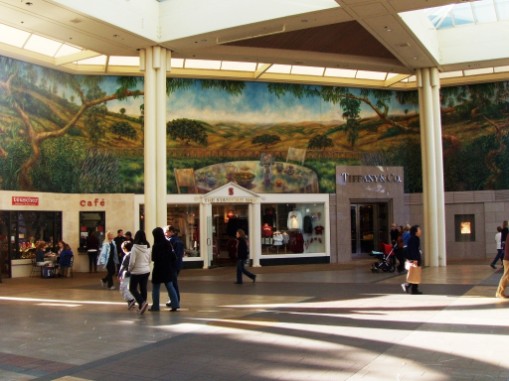
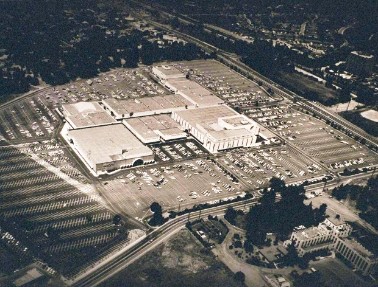
An overhead shot of the Shopping Center in the 1960s. (PAHA)
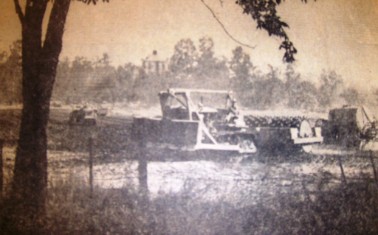
The building of the Stanford Shopping Center in Stanford's hay fields.
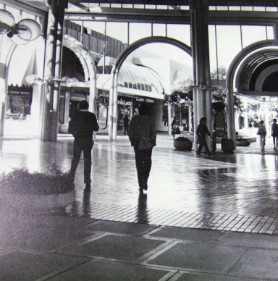
The Shopping Center in the 1980s. (PAHA)
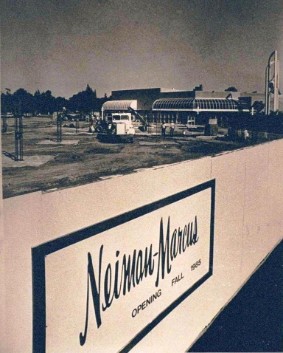
The construction of Neiman-Marcus in 1985. (PAHA)
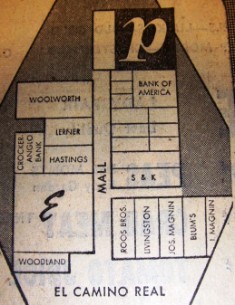
The original Stanford Shopping Center.
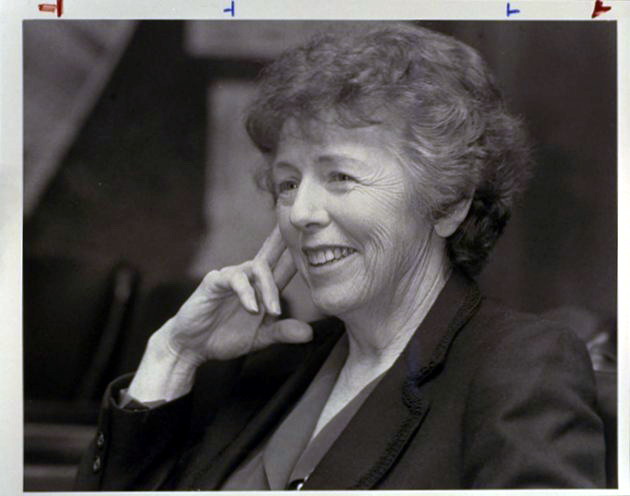
Rosemary McAndrews helped bring a new type of class to the old mall. (PAHA)